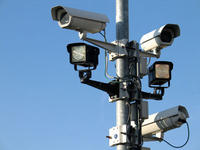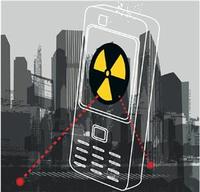-
PrivacySensors everywhere might mean privacy nowhere: Expert
Just as we are coming to grips with having less privacy in our lives thanks to the Internet, a new use of the technology is poised to present new questions about security and privacy — and create a new threat to society. The so-called “Internet of Things” will see small microprocessors and sensors placed seemingly everywhere, and these devices will collect much data about us — often without our knowledge. A second concern with the Internet of Everything is that we may have already crossed a threshold where a large event that would cripple these devices would mean that our current civilization would come to an immediate stop. An occurrence of a massive solar flare, like the 1859 Carrington Event, could disable all the devices on which we have come to depend. “If something like that were to happen, the Amish would become the only people without a major life upheaval,” says one researcher.
-
-
Law-enforcement technologyShotSpotter helps Washington, D.C. police track gunshots
Law enforcement officers in Washington, D.C are better equipped to track and monitor gunshots in the city’s most violent neighborhoods by using ShotSpotter, a system of rooftop sensors which recognizes sounds from gunfire. Law enforcement officials can track shooting incidents and also predict locations and time of future shooting incidents by analyzing records provided by ShotSpotter.
-
-
SurveillancePrivacy, cost concerns check drive for more surveillance cameras

Law enforcement agencies in cities across the United States are campaigning to increase surveillance on city streets, impressed with the effectiveness of video surveillance in helping the Boston Police identify the two suspects in the Boston Marathon bombings. This campaign to expand law enforcement’s surveillance power is likely to run into stiff opposition, as Americans have proven suspicious of allowing the government powers which would infringe on privacy. Expanding surveillance networks also costs money, and these are tight budgetary times.
-
-
Border securityProblems-plagued border sensor program put on hold by CBP
Two years ago, DHS cancelled SBInet, the ambitious Bush-era project to install advanced sensing technology along the border. The project was cancelled after more than $1 billion were spent on a few towers equipped with sensors which were built along a 28-mile stretch and the Arizona-Mexico border. Now CBP has put on hold one of SBInet’s successors, a project aiming to install sophisticated ground sensors along the U.S.-Mexico border.
-
-
Law-enforcement technologyProliferation of license plate readers worry privacy advocates
Automated License Plate Recognition (ALPR) technology has taken off in recent years, and the police says it is the greatest innovation since fingerprints and DNA; the technology has changed the way police finds cars connected to crimes, but in the process it has upset many privacy advocates
-
-
Underwater navigationTechnology emulates the Blind Cave Fish to help underwater vessels navigate with ease
Scientists have invented a “sense-ational” device, similar to a string of feelers found on the bodies of the Blind Cave Fish, which enables the fish to sense their surrounding and so navigate easily; using a combination of water pressure and computer vision technology, the sensory device is able to give users a 3-D image of nearby objects and map its surroundings
-
-
Tunnel detectionDetecting tunnels -- used to smuggle drugs, weapons, or people – is not easy
It seems reasonable to assume that it would be easy to use seismic waves to find tunnels dug by smugglers of drugs, weapons, or people, but this assumption is wrong; scientists are trying to get a better look at the ground around tunnels to learn why seismic data finds some tunnels but not others – and come up with a seismic detection process for the border and other areas where tunnels pose a security threat
-
-
Border securityDHS finally investigates Border Patrol policies on deadly force

It was reported last week that DHS’s Office of the Inspector General was investigating charges of excessive force by Border Patrol guards at the Mexican border; to change the dysfunctional culture prevalent among some Border Patrol agents in certain border stations, however, will require much more than an investigation by DHS IG of policies regarding the use of deadly force; what is required at a bare minimum is more, not less, professional training at the national academy, a legitimate mentorship program for all new agents by experienced mentors, legitimate agency support for continued professional development of agents, promotions based on merit rather than paternalistic decision-making, and a number of other reforms neither DHS nor the CBP are willing to acknowledge
-
-
Border securityBorder Patrol relies in obsolescent surveillance gear
An Obama administration plan to update equipment the Border Patrol is using did not materialize, and now officials are concerned about outdated equipment putting the lives of agents in danger; the sensors now in use were originally said to be able to put Border Patrol agents in position to capture 90 percent of border invaders, but the DHS inspector general determined that just 4 percent of the alarms were confirmed cases of smugglers and border crossers; 34 percent were false alarms, and 62 percent were undetermined
-
-
Border securityDHS submersible Pluto mimics the real narco-subs
In the early 1990s, South American drug cartels came up with a new tactic to transport narcotics destined for the United States: small, radar-dodging, self-propelled, semi-submersibles (SPSSs); better to address the submersible problem, DHS Science and Technology Directorate created its own submersible and called it Pluto, after the planet which is difficult to spot
-
-
Nuclear facilitiesY-12 and operator error
Three anti-nuclear activists, led by an 82-year old nun, breached the perimeter security system of the supposedly highly secure Y-2 nuclear facility at Oak Ridge, Tennessee, where nuclear weapons components are manufactured (note that the Oak Ridge National Laboratory [ONRL] is not affiliated with the Y-12 National Security Complex); they then spent several hours in a secure area of the facility, leisurely spray-painting slogans on the facility’s walls – without the facility’s security staff, or the sophisticated $500 million security cameras and sensors, detecting them; to understand what happened at Y-2, we must accept that operator error is an essential problem in national security, and that the problem is pervasive and normal; the only way to deal with the operator error phenomenon is to build redundancies into the system
-
-
Border securityUnderground spies to secure Indo-Pakistan border

With the discovery of a 400-foot long tunnel at the India-Pakistan Border, the IndianHome Ministry has decided to acquire Unattended Ground Sensors (UGS) that could be installed along the international border with Pakistan as an important line of defense
-
-
Nuclear monitoringMonitoring nukes with social media

Acting Undersecretary of State for Arms Control Rose Gottemoeller is actively trying to find a way to incorporate social media tools to prevent nuclear weapons proliferation and keep fissile materials out of the hands of terrorists; the department wants to have crowdsourcing tools developed that could help ordinary citizens monitor a government’s nuclear activity and whether it was adhering to its stated promises
-
- All
- Regional
- Water
- Biometrics
- Borders/Immig
- Business
- Cybersecurity
- Detection
- Disasters
- Government
- Infrastructure
- International
- Public health
- Public Safety
- Communication interoperabillity
- Emergency services
- Emergency medical services
- Fire
- First response
- IEDs
- Law Enforcement
- Law Enforcement Technology
- Military technology
- Nonlethal weapons
- Nuclear weapons
- Personal protection equipment
- Police
- Notification /alert systems
- Situational awareness
- Weapons systems
- Sci-Tech
- Sector Reports
- Surveillance
- Transportation
Advertising & Marketing: advertise@newswirepubs.com
Editorial: editor@newswirepubs.com
General: info@newswirepubs.com
2010-2011 © News Wire Publications, LLC News Wire Publications, LLC
220 Old Country Road | Suite 200 | Mineola | New York | 11501
Permissions and Policies
Editorial: editor@newswirepubs.com
General: info@newswirepubs.com
2010-2011 © News Wire Publications, LLC News Wire Publications, LLC
220 Old Country Road | Suite 200 | Mineola | New York | 11501
Permissions and Policies
